The Dish x AT,TP: Cooking Through Your Cycle
Miso soup, artichokes, hot buttered rice, rosemary chickpeas (more ideas than recipes)
Hello, everyone! Today’s post strays a bit from the normal Dish routine, as I was presented with a challenge by a friend and felt inspired to take it on.
This friend is named Becca Havian, and she writes a beautiful newsletter called A Third, Thin Place, which tackles subjects like community, mental health, and other important things that don’t always get airtime day to day. Becca has a Masters in Counseling from NYU and a Health Coaching Certificate from the Institute for Integrative Nutrition, and writes from a place of self-reflection and curiosity. Regarding the name of her newsletter, A Third, Thin Place, Becca explains that third places “are spaces that facilitate connection and community” — separate from home and work. She describes thin places as follows:
“The term ‘thin place’ was born of the Celtic tradition, and refers to ‘locales where the distance between heaven and earth collapses and we’re able to catch glimpses of the divine, or the transcendent.’ These are places that possess a shimmery quality.”
I love the name, and Becca’s work definitely has a shimmer to it.
As for the challenge she presented, it was to collaborate on content about cycle syncing. I accepted — eager to create with Becca, and to learn more about the topic at hand.
If you’re unfamiliar with the concept of cycle syncing, it’s the practice of paying attention to the phase of your menstrual cycle and aligning your lifestyle choices to support your wellbeing throughout the cycle. Becca will address cycle syncing from a more scientific and mood-oriented perspective on her Substack (read here!) and socials (Instagram, TikTok), while I’ll offer cycle-supportive recipe ideas for each phase. I came up with recipes to match what your body might be craving based on your hormonal state — and they aren’t very specific (by design!). These recipes are what I’d text you if you asked me how to make something; I encourage you to take the idea and run with it.
Disclaimer: It feels important to say that I’m not an expert on cycle syncing, and I don’t believe that any particular food will heal you. I’m opposed to creating rules around food, believing that there is a perfect way to eat and suggesting that there is a morality to the foods you consume.
However! I do believe in learning more about our menstrual cycles, filling in the gaps of what we’ve been taught, and listening to our bodies’ ever-evolving needs. We so rarely acknowledge the ways menstruating people’s bodies and minds fluctuate throughout our cycles, and there’s still much we don’t know about these waves. But I think that cooking nourishing, nutrient-rich meals to soothe yourself and your symptoms can only be a good thing.
Menstrual
This is the phase you’re likely most familiar with — when you’re actively on your period. Progesterone and estrogen are at their lowest levels, and discomfort and fatigue are common experiences. Hydrating, easily digestible foods can be beneficial for both body and mind at this time, so soups and stews are your friends! I’d cook this miso soup with mushrooms and silken tofu, which is barely a recipe (in the best way), and makes me feel calm, warm, and cared for. It’s a light dish, so feel free to add carbohydrates for more energy, like udon or soba noodles, or perhaps a bowl of rice. Cookbook author Sonoko Sakai is known to start every morning with a bowl of miso soup, which is a common practice in Japan and sounds like a lovely routine.
Miso Soup with Mushrooms and Silken Tofu
Ingredients: mushrooms, scallions, silken tofu, instant dashi powder, white miso
Bring a small pot of water to a boil. While you wait, thinly slice the mushrooms and scallions. Cut the silken tofu into small cubes. When the water boils, add the instant dashi powder and stir to dissolve. Remove from the heat. Add the mushrooms and scallions, then a spoonful of white miso. Stir to melt the miso into the dashi broth. Add the tofu and let it warm through. Serve!
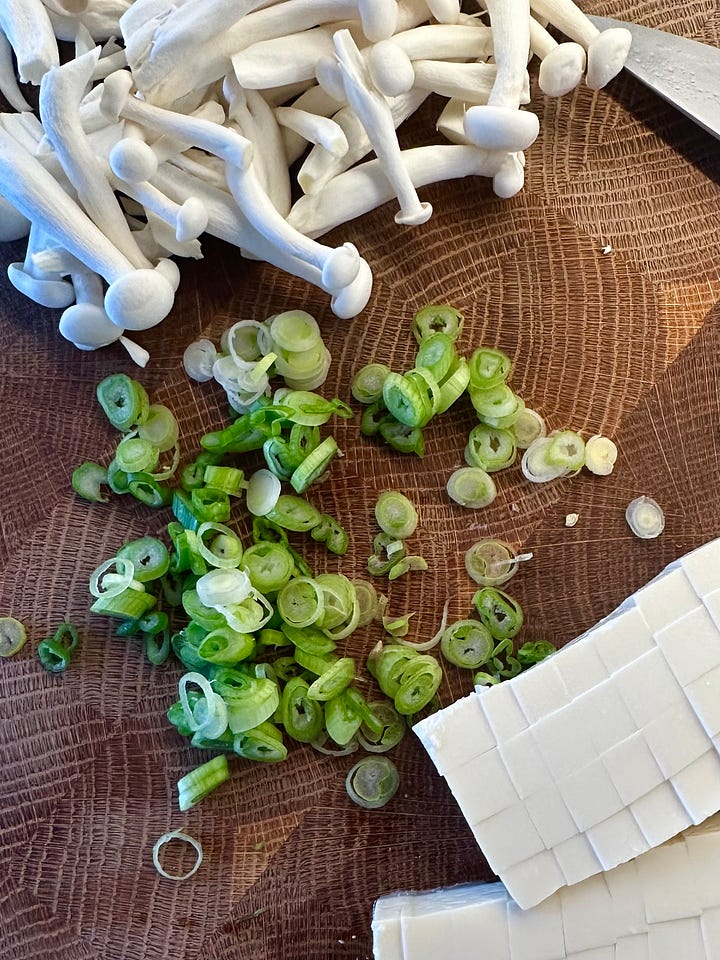
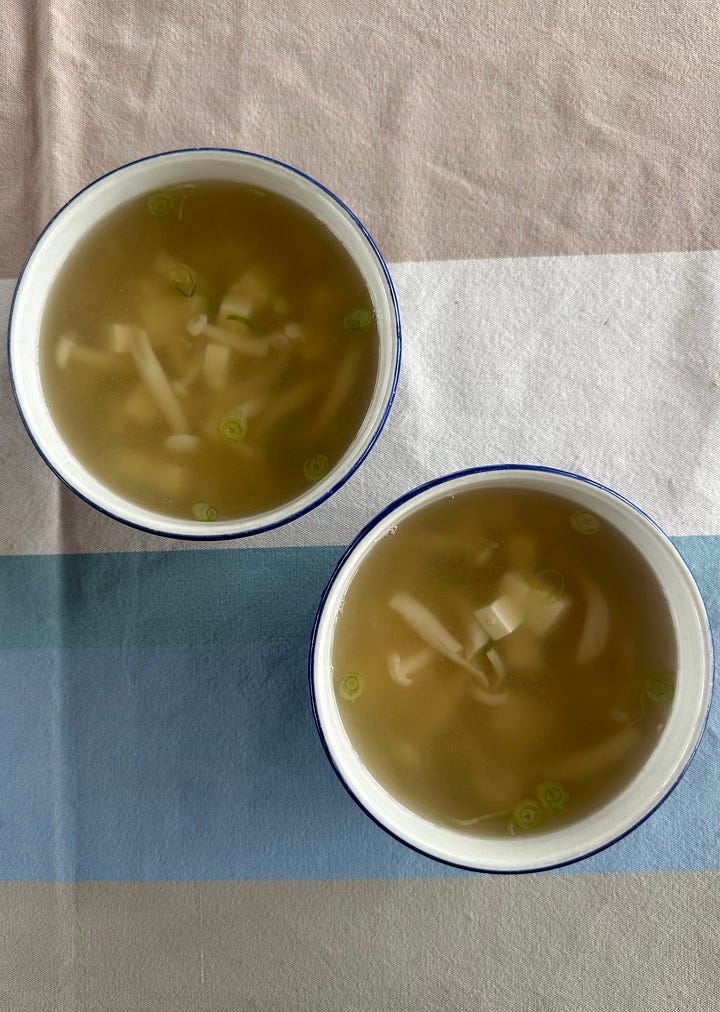
Follicular
As estrogen levels rise in the follicular phase, you may start to feel more energized and uplifted. Complex carbohydrates provide steady energy, while vegetables offer fiber and prebiotics to support gut health. I’d cook pesto pasta with artichokes, white beans, and lemon for a meal that’s hearty, vibrant, and energizing. This recipe relies on easy store-bought products and pantry staples, because nourishment doesn’t have to be fancy.
Pesto Pasta with Artichokes, White Beans, and Lemon
Ingredients: canned artichoke hearts, canned white beans, shallots, pasta, olive oil, salt, black pepper, lemon, pecorino
Cook the pasta/prep the veg: Bring a pot of salted water to a boil. Drain and rinse the artichoke hearts and white beans. Thinly slice a couple shallots and cut the artichoke hearts into quarters. When the water boils, add the pasta and cook according to package directions.
Cook the veg: Meanwhile, heat a drizzle of olive oil in a skillet. Add the thinly sliced shallots and season with salt and pepper. Cook until softened, then add the white beans and quartered artichoke hearts. Toss to combine and season to taste with more salt and pepper.
Finish the pasta: Reserve some pasta cooking water before draining the pasta and returning it to the pot. Add some cooking water back into the pot, along with a heaping spoonful of pesto. Toss, toss, toss over medium heat until the noodles are well-coated with sauce. Add the shallot-artichoke-white bean mixture into the pot and toss to combine.
Serve with lemon zest, grated pecorino, extra black pepper, and a final drizzle of olive oil.

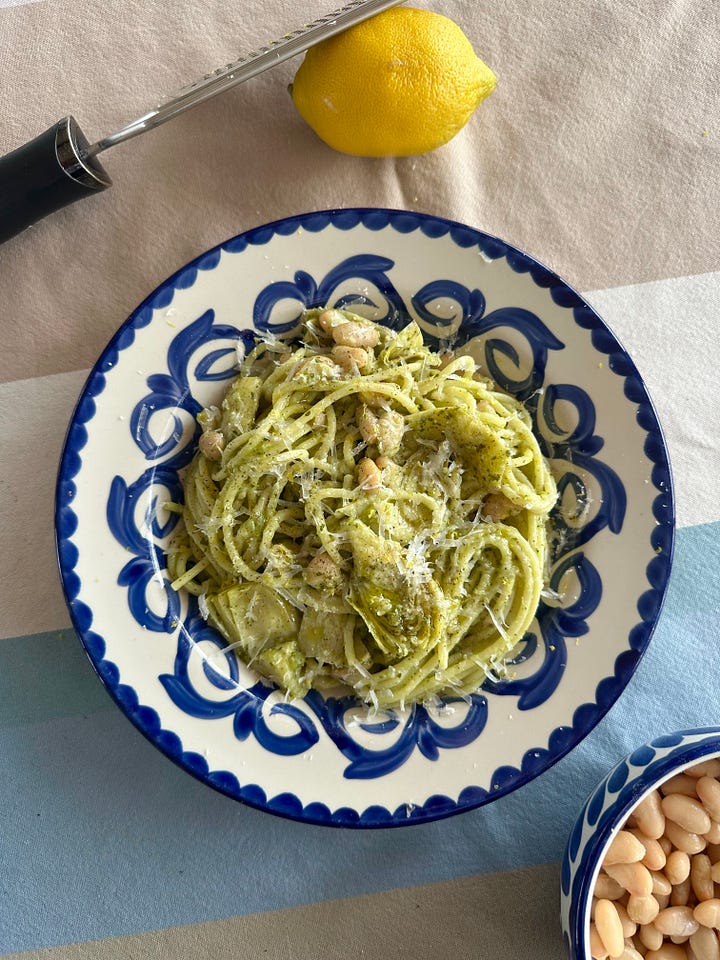
Ovulation
During ovulation, estrogen is at its highest level, fertility is at its peak, and emotional fluctuations can occur. Nutrient-dense foods like fatty fish (salmon, trout, etc.) and leafy greens (spinach, chard, etc.) can support hormone balance during this time. For a grounding, feel-good meal during ovulation, I’d cook salmon with sesame greens and hot buttered rice — nutrient-dense and comforting in equal parts.
Salmon with Sesame Greens and Hot Buttered Rice
Ingredients: salmon, olive oil, salt, rice, salted butter, spinach or chard (tough stems removed), olive oil, sesame oil, scallions (optional)
Cook the salmon: Preheat the oven to 300 F. Place salmon filets in a baking dish and drizzle generously with olive oil. (Salmon loves olive oil, so don’t be shy.) Season with salt. Transfer to the preheated oven, and cook for 20-30 minutes, until just cooked. (I’m giving a wide range because it depends a lot on the thickness of the fish, and I like salmon best when it’s buttery.)
Cook the rice: Meanwhile, cook some short-grain rice according to package directions, or in the rice cooker, if you have one. When the rice is cooked, add a generous pat of salted butter and use a wooden spoon to pad it in.
Cook the greens: Add a drizzle of olive oil to a skillet over medium heat. When hot, add a few handfuls of leaves — more than you think (they will wilt) — with a pinch of salt and cook for 4-5 minutes, until they’ve wilted and the water has mostly evaporated. Remove from the heat and season with another pinch of salt and a drizzle of sesame oil.
Serve it up! Salmon + greens + rice, with an extra pat of salted butter and some thinly sliced scallions on top, if you’d like.


Luteal
When progesterone levels rise, cravings can intensify, and the body benefits from more protein, iron, and magnesium. I’d cook steak with rosemary chickpea mash for a satisfying meal that’s rich in all three (protein, iron, and magnesium).
Steak with Rosemary Chickpea Mash
Ingredients: olive oil, steak, salt, black pepper, butter, rosemary, cooked chickpeas (homemade or from a jar1), chicken stock, garlic, lemon
Prepare the chickpea mash: Heat a drizzle of olive oil in a skillet over medium heat. Add a sprig of rosemary and let it infuse the oil for a couple minutes. Grate in a clove or two of garlic and cook briefly (about 30 seconds). Remove the rosemary sprig. Add some cooked chickpeas and a splash of chicken stock, and season with salt and pepper. Bring to a simmer to warm through, then remove from the heat. Use a potato masher or the back of a fork to mash the chickpeas. It will not be completely smooth, and that’s okay! You’re looking for a rustic mash. Add more chicken stock to loosen if needed.
Cook the steak: Season the steak on both sides with salt and pepper. Heat a cast iron pan over high heat. Add a drizzle of neutral oil and swirl to coat. Place the steak in the pan and cook without moving it for a few minutes. Flip and sear the other side for a few more minutes, until done to your liking. In the last minute or so, add a pat of butter and a sprig of rosemary to the pan. Spoon the melted butter over the steak before removing it from the heat and letting it rest for 5-10 minutes before slicing.
Serve the steak alongside the chickpea mash with a wedge of lemon to squeeze on top.
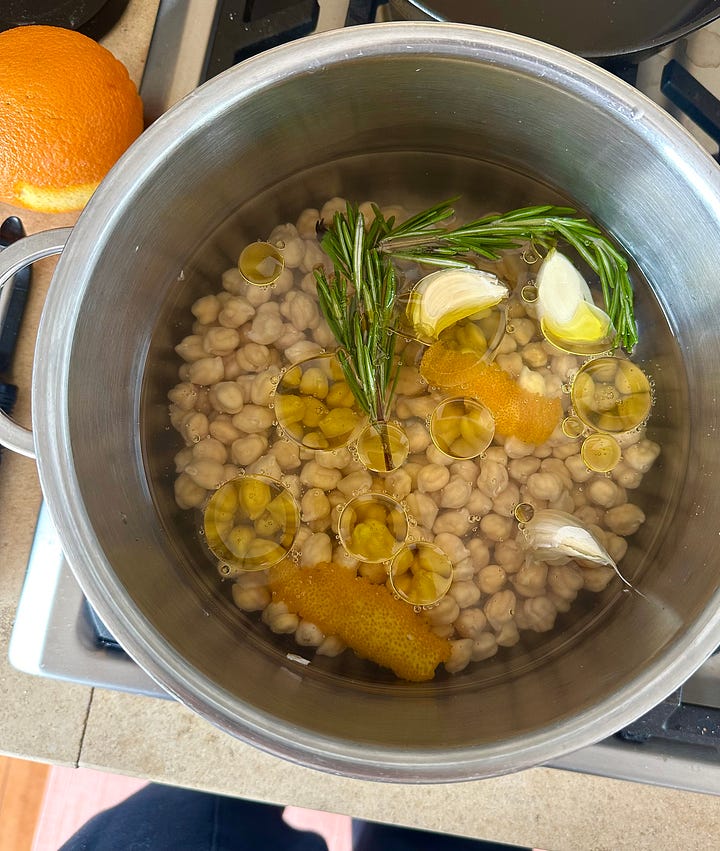
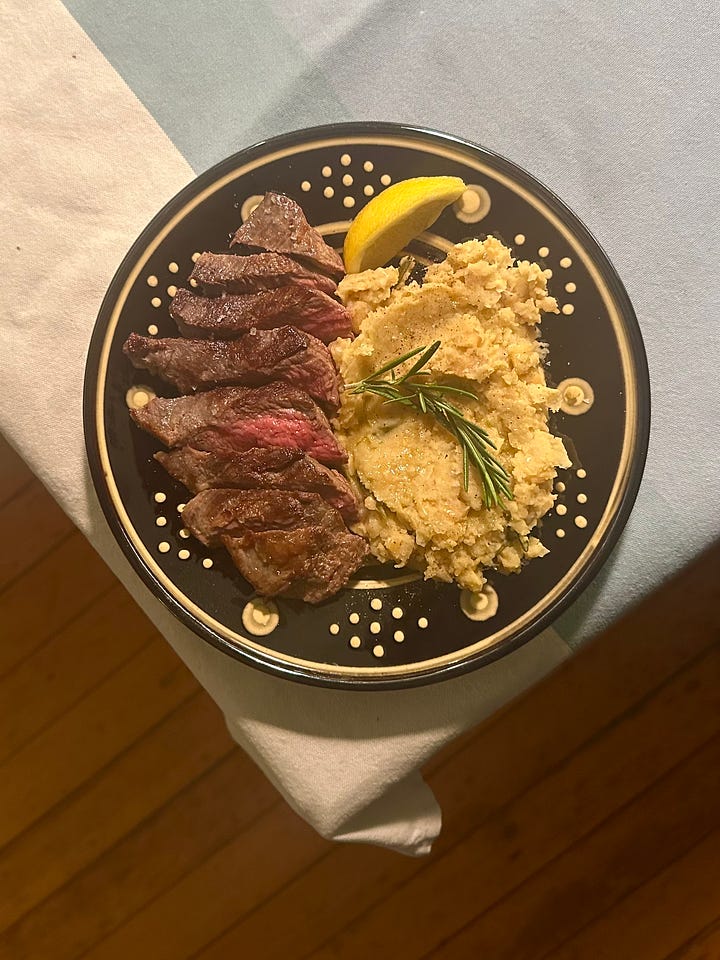
That was a long one! Thanks for sticking with me, and don’t forget to read Becca’s accompanying newsletter (and subscribe while you’re at it!).
xx Phoebe
Jarred chickpeas are preferable to canned here, since canned ones tend to be drier. (Homemade is ideal — but time-consuming!)

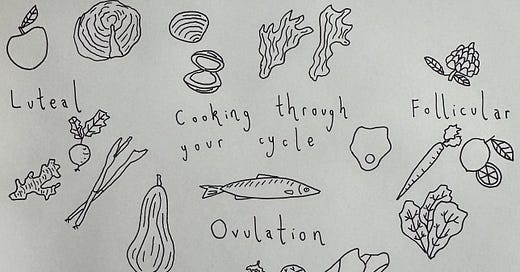



Instant subscribe- I have been searching for more cycle syncing recipes and a better understanding of my cycles and the role/benefit of certain foods within each phase. Thank you!! Can’t wait for more 🥰🥰
What a fantastic idea! And so glad to be introduced to the wonderful Becca's blog... brilliant. Will adapt these recipes to my only particular post-menopausal needs!! Go Becca Go Phoebe!!